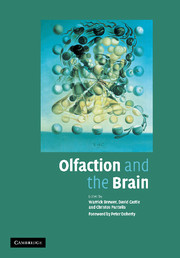Book contents
- Frontmatter
- Contents
- Foreword
- Preface
- List of Contributors
- Section I Neurology, Neurophysiology and Neuropsychology: Olfactory Clues to Brain Development and Disorder
- Section II Social Functioning: Role of Evolution, Genetics and Gender
- Section III Assessment and Disorders of Olfaction
- 13 Assessment of Olfaction
- 14 Olfactory Impairment in Neuropsychiatric Disorders
- 15 Olfaction in Parkinsonian Syndromes
- 16 Olfaction in Psychosis
- 17 Olfactory Hallucinations
- 18 Delusions of Body Malodour: The Olfactory Reference Syndrome
- Index
- Plate section
- References
14 - Olfactory Impairment in Neuropsychiatric Disorders
from Section III - Assessment and Disorders of Olfaction
Published online by Cambridge University Press: 17 August 2009
- Frontmatter
- Contents
- Foreword
- Preface
- List of Contributors
- Section I Neurology, Neurophysiology and Neuropsychology: Olfactory Clues to Brain Development and Disorder
- Section II Social Functioning: Role of Evolution, Genetics and Gender
- Section III Assessment and Disorders of Olfaction
- 13 Assessment of Olfaction
- 14 Olfactory Impairment in Neuropsychiatric Disorders
- 15 Olfaction in Parkinsonian Syndromes
- 16 Olfaction in Psychosis
- 17 Olfactory Hallucinations
- 18 Delusions of Body Malodour: The Olfactory Reference Syndrome
- Index
- Plate section
- References
Summary
Introduction
Being the most evocative of senses, olfaction produces powerful responses in humans and is used as a primitive but potent form of communication among animals. As discussed in Section 1, our understanding of the brain mechanisms underlying olfactory function has improved markedly in recent years, such that brain areas subserving various olfactory abilities have been identified. For example, it has been demonstrated that olfactory function can be broadly divided into acuity, identification ability and olfactory memory, and that each of these are subserved by interrelated cerebral systems. These systems are differentially affected in various neurological and neuropsychiatric disorders. In this chapter we briefly describe the functional neuroanatomical components of olfaction and then summarise the findings in various neurological and psychiatric disorders that are not covered elsewhere (see Chapters 1, 15–18; see also Pantelis et al., 2001).
Neuroanatomical elements of olfactory processing
The functional significance of the components of the olfactory cortex have been determined from experiments in animals, human lesion studies neurological disorders and, more recently from work using newer brain imaging techniques, such as positron emission tomography (PET), and both structural and functional magnetic resonance imaging (fMRI). As described in Chapters 2 and 3, early studies using PET and fMRI indicated that both pleasant and unpleasant odours activated predicted regions of the entorhinal and orbitofrontal cortices and the amygdala, although odours also activated additional areas in the medial prefrontal cortex including the anterior cingulate gyrus (Levy et al., 1998; Zald et al., 1998).
Keywords
- Type
- Chapter
- Information
- Olfaction and the Brain , pp. 259 - 278Publisher: Cambridge University PressPrint publication year: 2006
References
- 1
- Cited by



